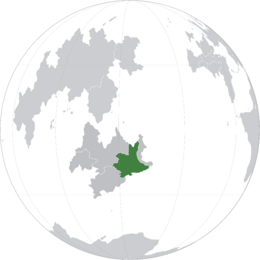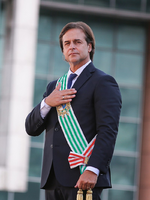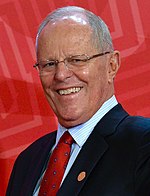Rocia
This article is incomplete because it is pending further input from participants, or it is a work-in-progress by one author. Please comment on this article's talk page to share your input, comments and questions. Note: To contribute to this article, you may need to seek help from the author(s) of this page. |
Republic of Rocia República del Roca (Palian) | |
|---|---|
 | |
| Capital | Sierra Blanca |
| Largest city | Verbo Divino |
| Official languages | Palian Runasimi |
| Ethnic groups | see Demographics |
| Demonym(s) | Rocian |
| Government | Unitary presidential republic |
| Federico de Riviera-Murillo | |
| Alejandra Corral | |
• Premier | Estéban Tinoco |
| Legislature | Congress of the Nation |
| Independence from the Kingdom of Palia | |
• Declared | 18 January 1797 |
• Recognised | 26 August 1812 |
• Dissolution of the Aillaca-Rocia Union | 2 March 1906 |
• Current constitution | 2006 |
| Population | |
• 2019 census census | 31,403,515 |
| GDP (PPP) | estimate |
• Per capita | $15,039 |
| GDP (nominal) | estimate |
• Per capita | $8,717 |
| HDI (2019) | 0.752 high |
| Currency | Rocian peso (RCP) |
Rocia (Palian: Roca), officially the Republic of Rocia (Palian: República del Roca), is a country in Marceaunia Minor. It is bordered by the Gulf of the Divine to the north, Aiyaca to the east, the Hesperian Ocean to south, and Amandine to the west. The country claims a larger border than it controls with Amandine through the disputed territory of Chawpisuyu. The capital is Sierra Blanca, located in the center of the country. Verbo Divino is the largest city and historical administrative center. Other major cities are Abancay, Carro, Jaén, and Ica.
Rocian territory has been home to human civilizations dating as far back as 3000 BCE. The Pioquinto civilization, which originated in neighboring Aiyaca, was the first civilization in Rocia. The last major civilization prior to colonization was the Amaru Empire empire. The Amaru controlled much of the territory including Rocia for over two centuries after it established hegemony over the region. Rocia's territory has one of the oldest histories of human settlement and civilization in the world, dating back to the 4th millennia BCE. Starting in the 16th century, the Kingdom of Palia came to control the region following a series of conquests. It established the Viceroyalty of Rocia which encompassed much of western Marceaunia Minor . The Viceroyalty was centered in Ciudad del Verbo Divino and was one of Palia's wealthiest and largest colonial possessions. During the Marceaunian Wars for Independence, parts of Rocia declared their independence from Palia in 1790. Fighting between loyalists and separatists, backed by foreign revolutionaries continued until 1812. Rocia formally declared independence in 1797 and shortly after formed the Aillacan-Rocian Union. In the years after its formation, the Union experienced relative economic and political stability. It also came to enjoy significant influence in continental affairs. Growing internal divisions and external threats resulted in the break-up of the Union in 1906 following the War of the Four Nations.
The current Rocian state was established in 1906. Throughout the first half of 20th century, the country had a series of conservative and authoritarian governments. Reformists and liberals made significant changes to Rocian society and from 1940 to 1960 conditions improved and the economy grew. Coups, social unrest, territorial disputes, economic inequality, ethnic tensions, and armed insurgencies characterized much of the late 20th century. The country underwent a period of democratization in the early 1980s and Horacio Calixto-Ortega was elected president in 1986. His government was credited with stabilizing the country, ushering in a period of economic development. However, Calixto-Ortega was heavily criticized for the suppression of political dissent and face allegations of human rights violations. Fernándo Ortolano was elected to the presidency in 2002 and was credited with ending the ongoing insurgencies, improving living conditions, and increasing rights for the indigenous population. The current constitution was implemented in 2006 and defines the country as a unitary presidential republic. Ortolano was removed from office in 2012 following allegations of corruption and the Chawpisuyu conflict began when several indigenous majority provinces declared independence.
Rocia, which has a population of over 31.4 million inhabitants, is a multiethnic country. Its population includes indigenous peoples, Mestizos, Auressians, and Idicans. The official and predominant language is Palian. Since 2006, Runasimi and [language] have been co-official languages. Over 40 additional indigenous languages are spoken in Rocia however none have co-official status.
The country is an active member of the Pending, the Pending, the Assembly of Marceaunian States, the Marceaunia Minor Common Market, and the Pending. The country is considered a middle power and has notable political and economic influence in Marceaunia Minor.
Etymology
The name of the country is believed to be derived from Ruq'a, the name of an Amarun ruler. When his possessions were visited and explored by Auressian explorers in the 16th century, they came to be designated Ruqa. This was Palianicized as Roca and Rocia in Rythenean.
The Kingdom of Palia gave the name official status when it designated its newly conquered regions in eastern Marceaunia Minor. During the era of Palian colonialism, the entire region was a part of the Viceroyalty of Rocia. This became the Union of the Ailliacan and Rocian Republics after independence. Following the Union's dissolution, it became the Republic of Rocia.
History
Pre-Auressian era
Colonial era
Independence and union
Rise of the modern nation

Following the dissolution of the Aillacan-Rocian Union, Bartolomé Pablo-Blanco led efforts to centralize power in Sierra Blanca and became the first president of the newly established country. He was succeeded by Alejandro Maravilla and Maximiliano Contreras Viveros. These three presidencies created the basis of the modern Rocian state and began a period known in Rocia as the años congelados (literally "frozen years"). Starting with Pablo-Blanco, Rocia had four consecutive federal governments that implemented conservatism and were authoritarian in nature. The Rocian economy experienced a period of slow development. Much of the economy was controlled by powerful business magnates. Important economic sectors also came under foreign influence and control. Corruption was widespread during this period and many politicians had close ties with Rocian industrialists and foreign companies. President Estéban Castano attempted to seize the disputed Machamaca region from Aiyaca in 1929. Rocia's defeat by Aiyaca in the Machamaca War resulted in the gradual end of the años congelados.
The liberal presidencies of Luis Carrizales-Pena and Silvestre Pastrana followed. Liberal economic policies were implemented under both presidents. Rocia's economic outlook began to improve while foreign corporations an major business owners lost influence. Pastrana was impeached and removed from office in 1944 after a corruption scandal. He was succeeded by Leopoldo Pérez, the conservative vice president. Pérez rolled back many of his liberal predecessors' policies and was a weak administrator. An economic crisis in 1946 resulted in the resignation of his government and the transitional presidency of Vicente Barboza, the senior statesmen in the legislature.
Barboza held the presidency until the 1947 election which saw Salomón Pacheco become president. Pacheco was a labour leader and was popular among workers. He created a political movement known as Pachequism. Nationalist and labourist views were espoused by Pacheco. Under his leadership, many important industries were nationalized. Wages were increased, welfare and healthcare were expanded, and social reforms were enacted. Pacheco was re-elected in 1952 and 1956. During this period, government expenditure increased significantly and Rocia acquired a large public debt. Pachequism initially had the support of both the clergy and the military. However, overtime Pacheco sought to curtail the influence of his former allies. He implemented restrictions on the clergy and reorganized the military. His brother, Horacio Pacheco, was elected president in 1960. The military removed Pacheco in a coup d'état in 1961. A new military government that sought to rule indefinitely took control of the country.
Late 20th century

Modern era
The country underwent a period of democratization beginning in 1983. A new constitution was adopted that established a semi-president republic with a strong central government. A transitional government led Rocia for a three-year period as the new constitution was drafted and ratified. Horacio Calixto-Ortega was elected to the presidency in 1986. His government was credited with stabilizing the country, ushering in a period of economic development. He directed the military to crackdown on separatists in the southern region of the country. An aggressive campaign by the military and paramilitary groups with alleged ties to the government allowed the government to exert some control in regions it previously did not control. By 1990, he was able to end several low-level insurgencies that had been going on prior to democratization. Under Calixto-Ortega, economic reforms were issued that addressed agriculture, state ownership of key industries, and foreign direct investment. Privatization and industrial deregulation were key policies implemented during this period. Free trade agreements were also aggressively pursued by the Calixto-Ortega government. This resulted in nearly two decades of steady of economic growth. The Mirandista insurgency began in 1991 in response to his government's economic policy and disregard for indigenous lands. Calixto-Ortega was defeated in 1994 by Agustín Corrall and Rocia had its first democratic transfer of power in over fifty years. Power was again transferred in 1998 when Mariano Montes, Calixto-Ortega's vice president, defeated Corrall.
Fernándo Ortolano was elected to the presidency in 2002 and was credited with ending the ongoing insurgencies, improving living conditions, and increasing rights for the indigenous population. Ortolano made history as the country's first Mestizo president. He negotiated an end to the ongoing Mirandista insurgency in 2003 and secured a cease-fire agreement that reintegrated insurgent controlled territories into Rocia and provided amnesty for Mirandista fighters. A new constitution was ratified in 2006 that established Rocia's current system of government. It reformed the central government into a presidential system and increased representation and protections for the indigenous population. The Ortolano government introduced a number of radical economic reforms, including the merger of hundreds of companies into partially state-owned ventures, increases in state-spending and investment in rural areas, and higher taxes on the wealthy. Ortolano was removed from office in 2012 following allegations of corruption. Amid pressure from the military, his vice president and entire government resigned from their positions after Ortolano's impeachment. Federico de Riviera-Murillo declared himself acting president and was elected for the first time in 2016. Many of Ortolano's policies were reversed or have been ignored by the current government. In response to Ortolano's removal and changes made by his successor, the Chawpisuyu conflict began when several indigenous majority provinces declared independence. The conflict remains ongoing and continues to present challenges to the Rocian government.
Government and politics
Government
Rocia has been democratically governed since 1983. Prior to democratization, it was governed by various dictatorships for decades. As outlined in the nation's constitution, Rocia is a unitary constitutional republic and representative democracy. The current system of government, which maintains a system of checks and balances and is a multi-party system, was implemented under the 2006 Constitution. As a unitary republic, the central government holds the most power and has the ability to create and dissolve administrative divisions.
The national government is composed of three branches:
- Executive: the 2006 constitution cemented the powers of the executive branch. It is led by the president and the vice president. Executive powers are concentrated in the presidency. The president and vice president are elected by a national popular vote to a five-year term. The executive branch also consists of the premier and 16 ministers. The premier and government ministers together control domestic legislation on behalf of the president, who appoints the premier and ministers. Four members of the cabinet must be women and two must be indigenous.
- Legislative: the bicameral Congress of the Nation consists of two chambers. The Chamber of Deputies has 225 deputies. Members are elected to five-year terms and are selected from a mix of multi-member districts, proportional representation, and minority indigenous peoples of several governorates. The Senate has 64 members. Four senators are assigned to each of Rocia's 16 governorates. The Vice President serves as the presiding officer of the Chamber of Deputies while the Senate elects its own presiding officer. 25% of the members of both houses must be women.
- Judiciary: includes the Supreme Court and lower national courts. These courts interoperate laws and overturn laws found to be unconstitutional. It is independent of both the Executive and Legislative branches. The eleven members of the Supreme Court are appointed by the President and are subject to the approval of the Senate. Members serve for life. Judges on lower courts are proposed by the Ministry of Justice and are appointed by the President after Senate approval.
Rocia's multiparty democracy has a wide variety of parties. From 1983 to 2002, the predominate parties were the People's National Movement and the Worker's Democratic Action. The left-wing ¡UNIDAD!, part of the Organized Left electoral bloc, was first elected in 2002 and formed a series of governments until 2012 following the impeachment of Fernándo Ortolano. After his impeachment, his government resigned and vacated their positions. Afterwards, Federico de Riviera-Murillo declared himself acting president and was elected for the first time in 2016. de Riviera-Murillo comes from the right-wing People's National Movement.
Administrative divisions
Rocia has 16 governorates (gobernación): Abancay, Aillaca Exterior, Churcampa, Jaén, Lacasa y Campos, La Libertad, La Serena, Mar de Roca, Norte Salta, Puerto Esperanza, Río Maracaí, Salta, Saxasaxa, Sierra Blanca, Verbo Divino, and Yana Orjo.
According to the 2006 constitution, the governorates draw all of their authority from the central government. The central government reserves the right to create and dissolve governorates as well as grant and revoke devolved powers. Governorates are led by a governor who is popularly elected. Each governorate has an assembly with the power to legislate. They are grouped into regions, though these groupings have no political implications and exist for the central government to coordinate the delivery of services to the governorates.
Municipalities, some of which are also governorates, elect a mayor and a municipal assembly. Some indigenous regions are granted special powers by the 2006 constitution, allowing them self-governance within their territories.
Foreign relations
Since democratization, Rocia's foreign relations have been dominated by its close relationships with Auressia and Marceaunia Minor. Rocia is a founding member of both the the Assembly of Marceaunian States and the Marceaunia Minor Common Market. It also participates in several regional and cultural organizations. Rocia was admitted to the Congress of Nations in 1923 and has actively participated in the organization since.
Trade and economic development have been at the forefront of Rocian foreign policy since the 1980s. Successful attempts to stabilize and reform the economy have allowed the country to pursue closer economic ties with other nations. Rocia has several major free trade agreements, most notably with the Pending, Pending, and many others.
It also maintains an integrated relationship with other nations in Marceaunia Minor. It is a participating member in several intergovernmental organizations for Marceaunian Minor nations, including the Marceaunia Minor Common Market and the Organization of Marceaunian Minor Governments. Rocia was also a founding member of the Lacasine Alliance of Marceaunia until it suspended participation in the organization in 2013 and withdrew in 2015. The country historically has strained ties with Aiyaca, resulting in several territorial and diplomatic disputes since the dissolution of the Aillacan-Rocian Union in 1906. Ties between the two nations warmed from 2002 to 2012, but worsened following the impeachment of Fernándo Ortolano. The Chawpisuyu conflict has also strained Rocia's relationships with other nations in Marceaunia Minor and has drawn international criticism.
Rocia is also a participating member of the Pending, the Pending, the Pending, and many other intergovernmental organizations.


